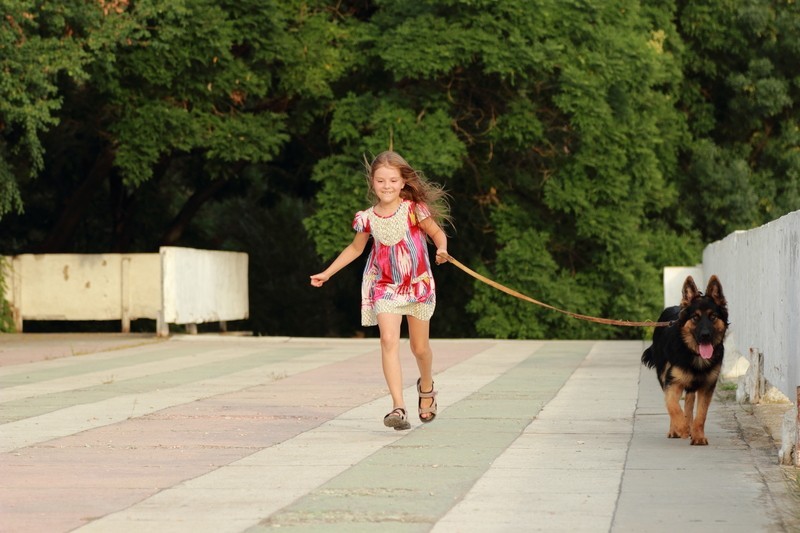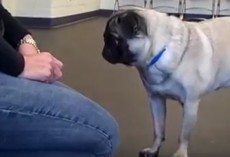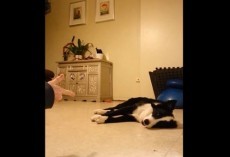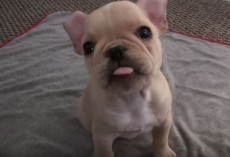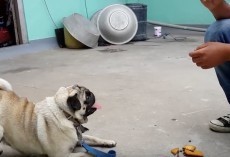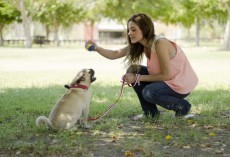So you've got your pooch, but what else do you need to start training them? Luckily, you don't need much:
- Patience (trust us, it helps!)
- A dog leash (a 6ft leash is best)
- Tasty treats – preferably soft ones they can chew/eat quickly. Also, break them up into smaller pieces so you have more to work with.
- Dog collar (do no use a choke-chain, harness or pronged collar to train your dog)
Option One: Red Light, Green Light
(This method requires that your dog already have a reliable Sit and Come in distracting places.) Walk in your intended direction. The instant your dog reaches the end of his leash and pulls, red light! — stop dead in your tracks and wait. When he stops pulling and puts slack in the leash (maybe he turns to see what you’re doing and this makes the leash a little slack), call him back to you. When he comes to you, ask him to sit. When he does, say “Yes,” give him a treat and resume walking (green light). If your dog looks up at you in anticipation of more tasty treats, quickly say “Yes,” and give him one while you keep walking. If he pulls again, repeat the red-light step above. As you’re walking, reward your dog frequently for staying next to you or slightly ahead and for looking up at you. If you do this consistently, he’ll learn that 1) if he stays near you or looks at you, he gets treats and gets to keep moving, and 2) if he pulls on the leash, the fun stops because he doesn’t get to keep walking and he has to come back to you and sit. If your dog pulls toward an object to sniff or eliminate, carry out the red light, but when he comes back and sits by you, don’t reward him with a treat. Instead, make the object he wanted to sniff the reward. Say “Yes,” and release him to go to the object. (Make sure you go with him toward the object so that he doesn’t have to pull again to reach it.) After a few days or weeks, you’ll find yourself stopping less frequently. Make sure you continue to reward your dog for walking with slack in the leash or he’ll start pulling again.
Option Two: Lure and Reward
Start with your dog standing at your left side. With several treats enclosed in your left hand, hold your left hand right in front of your dog’s nose (within 1 inch of it). Say “Let’s walk,” and walk in your intended direction. Every few seconds, pop a small treat into your dog’s mouth and praise her for walking along at your pace. You’ll need to frequently reload your hand with treats from your left pocket or from a treat pouch attached to your waist. If she pulls ahead or to the side, immediately stop. Get your dog’s attention by calling her name again. Ask her to sit, and praise her when she does. Then put the treat-loaded hand back in front of her nose and start walking again. Go a little bit farther every day that you practice. After at least a week of daily practice with lured walking, stop luring her along with your treat-loaded hand, and instead just carry your empty left hand in a natural position at your waist with elbow bent. Say “Let’s walk,” and reward her, about every other step you take, with a treat that you get from your left pocket or waist treat pouch. When she can walk along without pulling for several minutes, begin gradually increasing—over many daily training sessions—the number of steps you go in between treats so that your dog is walking longer distances between rewards. Reward her every other step at first, then every 5 steps, then every 10, and so on. Eventually, you should be able to walk with your hand comfortably at your side, periodically (every minute or so) reaching into your pocket to grab a treat to reward your dog.
Option Three: About-Face
(Use only if your dog is not wearing a choke, pinch or prong collar, or any head halter, such as Halti®, Gentle Leader®, etc.)
Please Note: Options Three and Four use punishment. Punishment should decrease behavior quickly. If it doesn’t result in a noticeable decrease in pulling after several training sessions of consistent use, then it should be stopped. Ineffective punishment repeated over and over easily escalates and can become abusive. Stop both these methods if your dog yelps in pain, becomes reluctant to walk with you, becomes aggressive, or shows fearful body language like cringing, cowering, trembling, excessive panting, tail tucking, etc.
For some dogs, stopping and waiting or luring with treats is not sufficient for them to understand that they shouldn’t pull. Instead of stopping, teach the dog that when he pulls, it’s a signal for you to turn and walk back the way you came. You need to incorporate a verbal warning into this sequence. Before your dog reaches the end of the leash, say “Easy.” If he slows down, say “Yes!” and call him back to you for a treat (but keep moving). If he does not slow down but gets to the end of the leash and starts pulling, don’t say anything to the dog. Just turn abruptly, letting the leash check your dog. As your dog runs to catch up to you, praise him. When he reaches you, turn and walk in your original direction. If he pulls again, turn around again. He will learn that pulling is unpleasant because he gets checked against the end of the leash and he gets farther away from his destination. Be sure to follow the same instructions as above for rewarding the dog when he walks without pulling.
Be advised that if your dog is running at full speed toward the end of the leash, you could inflict physical damage to his neck if you allow the leash to check him without giving him any slack. Allow your arm to absorb most of the force when you turn so the dog is surprised but not harmed.
Option Four: Collar Correction
(Use only if your dog is not wearing a choke, pinch or prong collar, or any head halter, such as Halti®, Gentle Leader®, etc. )
Some dogs may respond to a jerk on the collar when they pull. Walk holding the end of the leash near your left side, with your elbow bent. Don’t let your dog pull your arm straight out in front of you because then you won’t have the slack you need for the collar correction. You need to incorporate a warning into this sequence. Before your dog reaches the end of the leash, say “Easy.” If he slows down, say “Yes!” and call him back to you for a treat (keep moving). If he does not slow down and gets to the end of the leash and starts pulling, jerk sharply on the leash backward and upward. To do this, you’ll need to reach your arm forward a few inches to give yourself the slack on the leash to jerk back. Make sure your action is a jerk and not a pull. You may need to do this a couple of times before the dog slows down. How much pressure you exert when you apply the jerk depends on the dog. If your dog is small or sensitive, you will need only slight force. If your dog is large and tenacious, you may need stronger force. Be sure to quickly reward with treats and praise any time your dog isn’t pulling and walks with you with the leash slack.
We love the methods outlined above from our fellow dog lovers at the ASPCA. We can't stress enough how important it is to be patient with your dog. Keep in mind, unlike children, they have no way of adopting the human language. So they have a disadvantage. That's not to say dogs are not smart – quite the contrary! Dogs are incredibly intelligent animals and are capable of much more than people know. But being patient with your pup while they learn a new trick or obedience step is essential. A happy dog will learn much faster than an anxious dog who's scared of displeasing their owner. So keep that in mind.
Happy training!
